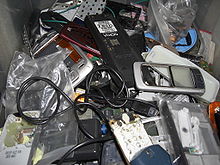- Mobile phone recycling
-
Mobile phones are able to be recycled at the end of their life.
Rapid technology change, low initial cost, and even planned obsolescence have resulted in a fast-growing surplus, which contributes to the increasing amount of electronic waste around the globe. Recyclers consider electronic waste a "rapidly expanding" issue.[1] In the United States, an estimated 70% of heavy metals in landfills comes from discarded electronics,[2] while electronic waste represents only 2% of America's trash in landfills.[3]
While some recycle, 7% of mobile phone owners still throw away their old phones. Mobile phones are "considered hazardous waste" in California; many chemicals in such phones leach from landfills into the groundwater system.[4] Environmental advocacy group Greenpeace claims that the soldering of the iPhone battery into its handset hinders its being recycled. It also states that its scientists found toxic phthalates on iPhone cables, and it holds that this contravenes California's Proposition 65, which requires warning labels on products exposing consumers to phthalates.[5]
Because the United States has not ratified the Basel Convention or its Ban Amendment, and has no domestic laws forbidding the export of toxic waste, the Basel Action Network estimates that about 80% of the electronic waste directed to recycling in the U.S. does not get recycled there at all, but is put on container ships and sent to countries such as China.[6][7][8][9] Guiyu in the Shantou region of China, and Delhi and Bangalore in India, have electronic waste processing areas.[6][10][11]
Regulation
The regulation governing mobile phones in the European Union is the Waste Electrical and Electronic Equipment Directive, implemented in 2003 (WEEE Directive, 2002/96/EC).[12] It was intended to make equipment manufacturers financially or physically responsible for their equipment at the end of its life, under a policy known as extended producer responsibility (EPR).[13]
In Switzerland, an early electronic waste recycler, it is possible to return surplus mobile phones to the sales points and other collection points free of charge. SWICO is the established Producer Responsibility Organisation.[14]
The main United States law governing solid waste is the Resource Conservation and Recovery Act of 1976, which covers only cathode ray tubes. No federal standard covering smartphones or electronic waste has arisen, although the U.S. Congress considers bills like the National Computer Recycling Act introduced by Congressman Mike Thompson (D-CA), and state regulations differ widely.[15]
Recycling kiosk
ecoATM has the first phone-recycling kiosk. They maintain a database of more than 4,000 mint-condition handsets. After connecting with an appropriate cable, the machine will scrutinize the condition of the phones, offer to erase the data and dispense cash based on the resale value. 10 ecoATMs have already recycled 33,000 phones with average payout $9 per phone, and 500 more kiosks are planned.[16]
See also
- Computers and the environment
References
- ^ Prashant, Nitya (2008-08-20). "Cash For Laptops Offers 'Green' Solution for Broken or Outdated Computers". Green Technology (Norwalk, Connecticut: Technology Marketing Corporation). http://green.tmcnet.com/topics/green/articles/37567-cash-laptops-offers-green-solution-broken-outdated-computers.htm. Retrieved 2009-03-17. In "Opinion". National Center For Electronics Recycling News Summary (National Center For Electronics Recycling). 2008-08-28. http://www.electronicsrecycling.org/public/NewsletterViewer.aspx?message=sent&id=40. Retrieved 2009-03-17.
- ^ Silicon Valley Toxic Corporation. "Poison PCs/Toxic TVs Executive Summary". http://www.svtc.org/site/DocServer/ppcttv2004.pdf?docID=301. Retrieved 2006-11-13.
- ^ Slade, Giles (2007-04-01). "iWaste". Mother Jones. http://www.motherjones.com/commentary/columns/2007/03/iwaste.html. Retrieved 2007-04-03.
- ^ Judkis, Maura (2008-07-30). "4 Ways to Earn Cash for Recycling". Fresh Greens. U.S. News and World Report. http://www.usnews.com/blogs/fresh-greens/2008/7/30/4-ways-to-earn-cash-for-recycling.html. Retrieved 2008-03-05.
- ^ Greenop, Matt (2007-10-18). "Greenpeace slams Apple over 'toxic' iPhone". New Zealand Herald. http://www.nzherald.co.nz/technology/news/article.cfm?c_id=5&objectid=10470675. Retrieved 2009-03-17.
- ^ a b Basel Action Network and Silicon Valley Toxics Coalition (2002-02-25). "Exporting Harm: The High-Tech Trashing of Asia" (PDF). Seattle and San Jose. http://www.ban.org/E-waste/technotrashfinalcomp.pdf.
- ^ Chea, Terence (2007-11-18). "America Ships Electronic Waste Overseas". Associated Press. http://biz.yahoo.com/ap/071118/exporting_e_waste.html?.v=3.
- ^ Slade, Giles (2006). "Made To Break: Technology and Obsolescence in America.". Harvard University Press. http://www.hup.harvard.edu/catalog/SLAMAD.html.
- ^ Carroll (January 2008). "High-Tech Trash". National Geographic Magazine Online. http://ngm.nationalgeographic.com/ngm/2008-01/high-tech-trash/carroll-text.html.
- ^ "Activists Push for Safer E-Recycling". http://www.npr.org/programs/watc/features/2002/apr/computers/index.html. Retrieved 2006-11-13.
- ^ "Computer age leftovers". Denver Post. http://www.denverpost.com/perspective/ci_3633138. Retrieved 2006-11-13.
- ^ "Waste Electrical and Electronic Equipment". http://eur-lex.europa.eu/LexUriServ/LexUriServ.do?uri=OJ:L:2003:037:0024:0038:EN:PDF.
- ^ "Lost In Transposition?". Greenpeace Report. Greenpeace International. 2006-09-27. http://www.greenpeace.org/international/press/reports/lost-in-transposition.
- ^ "Umwelt Schweiz". http://www.umwelt-schweiz.ch/buwal/eng/fachgebiete/fg_abfall/abfallwegweiser/e-schrott/index.html. Retrieved 2006-11-24.
- ^ "Final Rules on Cathode Ray Tubes and Discarded Mercury-Containing Equipment". U.S. Environmental Protection Agency. http://www.epa.gov/epaoswer/hazwaste/recycle/electron/crt.htm.
- ^ http://www.popsci.com/bown/2010/product/ecoatm
Further reading
- Geyer, Roland; Vered Doctori Blass (2009). "The economics of cell phone reuse and recycling". The International Journal of Advanced Manufacturing Technology 47 (5-8): 515–525. doi:10.1007/s00170-009-2228-z. ISSN 0268-3768.
External links
Recycling by product Categories:
Wikimedia Foundation. 2010.

